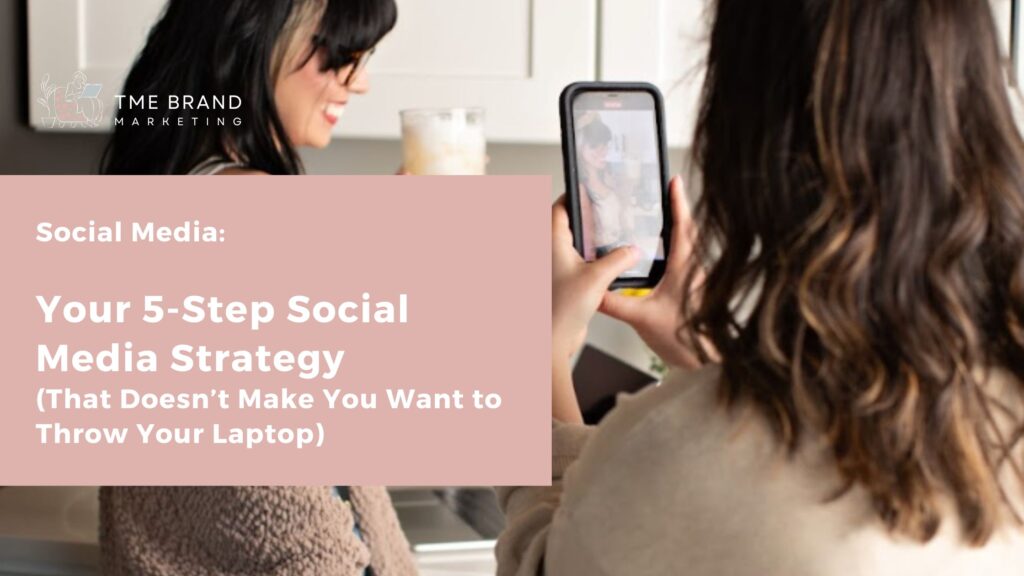
Your 5-Step Social Media Strategy (That Doesn’t Make You Want to Throw Your Laptop)
Let’s be honest—social media can feel like a never-ending game of “Why did this post flop?” One day you’re proud of your perfect Canva quote card, and the next day your reel gets 3 views, and one of them is your aunt who thinks you’re a life coach.
If you’re a therapist trying to market your practice online without losing your voice (or your mind), we got you.
Here’s the 5-step strategy we use to help therapy practices stand out online, speak clearly, and stop screaming into the social media void.
The 5 Steps:
Define your brand voice. (Make it human, not robotic.)
Know your audience. (Speak to their pain, not just their needs.)
Set clear goals. (Make your content work for your business.)
Create signature messages. (Repeat your core themes with confidence.)
Use AI wisely. (Teach it your voice and don’t let it embarrass you.)
Step 1: Define Your Brand Voice (Without Sounding Like a Self-Help Book)
Your brand voice isn’t just “supportive and trauma-informed.” That’s a given.
Ask yourself this: If your therapy practice gave a toast at a wedding, what would it sound like?
Would it be calm and steady with the perfect words for the moment? Or warm, real, and funny—like the kind of therapist who drops a Taylor Swift lyric mid-session and still gets to the root of your anxiety?
Pick 3 adjectives that describe your vibe. Are you direct, compassionate, and relatable? Or bold, authentic, and no-frills?
Pro Tip: Your voice should reflect you—not the vague jargon your grad school brochure was written in.
Need help putting it all together? We’re here for the strategy, batching, and brand therapy.
Let’s chat. Book a free 15-minute call and we’ll take a look at what you’re doing now, what’s working (or not), and where we can help you grow. Whether you need strategy, content ideas, or someone to just take it off your plate, we’ve got you. No pressure, no awkward pitch—just real talk and smart solutions.
Step 2: Get Real About Your Audience (Hint: It’s Not “Everyone Who Needs Therapy”)
If you’re trying to speak to “everyone,” you’ll end up connecting with no one—except maybe other therapists who just want to steal your content ideas.
So, who are you really talking to? Single moms trying to break generational cycles? Teens struggling with anxiety? Burned-out high achievers who cry in their car between meetings?
Get specific. What are they googling at 2 a.m.? What do they think is “too much” to bring up in session?
When you talk to one person really well, they feel seen—and that’s where the magic happens.
Step 3: Clarify Your Business Goals (Before You Post Another “Now Accepting Clients” Graphic)
Be honest. What’s the goal of your content?
Are you trying to…
Fill your caseload with ideal clients?
Promote a group therapy offering?
Educate your audience to build trust?
Position yourself as a thought leader or supervisor?
Define it. Own it. Let it guide your strategy.
Example: If your goal is to fill your DBT group for teens, then your content should speak directly to overwhelmed parents searching for emotional regulation tools—not just general mental health tips for everyone.
Step 4: Create Your 3 Signature Message Points (And Say Them on Repeat Without Apology)
These are the core messages you want to be known for. Not fluffy taglines—actual beliefs you can back up.
Here’s what that looks like for a trauma therapist, for example:
Healing takes time—but it’s possible.
You don’t have to carry your pain alone.
Therapy should be a judgment-free zone.
You can (and should) repeat these themes in different formats: reels, stories, quote graphics, blogs, memes, whatever. People need to hear it more than once—and that’s branding, not redundancy.
Hot Take: Your audience isn’t tired of hearing your message. They’re tired of the mental health fluff that doesn’t speak to their real life.
Step 5: Let AI Help (But Don’t Let It Write Like a Clinical Textbook)
We love AI. But it needs training—kind of like an eager intern with no filter.
So teach it. When using tools like ChatGPT, set your brand voice, audience, and signature messages ahead of time.
Then ask things like:
“Write 5 Instagram captions for overwhelmed moms trying to balance everything.”
“Write a 2-paragraph LinkedIn post about the signs of burnout in therapists.”
“Give me a weekly content plan for a therapist who works with teens and parents.”
Reminder: You still need to review and edit. Delete the cringe emojis. Add your personal flair. Ask it to “make it sound more like me—relatable but wise.”
Need a trick? Paste in 3 captions you’ve written before and tell AI to match that tone moving forward.
Bonus Round: What Not to Post (Because You’re Not Running a Burner Account)
This might seem obvious, but you’d be surprised…
Avoid:
Calling out other therapists or therapy modalities you don’t like
Oversharing personal drama that doesn’t tie into your brand
Treating your business page like a diary (save that for your Notes app)
Use this gut check before posting:
Would I say this in a session? Would I say this in front of my clients or colleagues?
Post the cozy therapy office setup. Share your dog snoring during a virtual session. Share the real struggles of being a therapist and mom trying to do it all. Just stay rooted in your mission.
SCHEDULE A CALL
Free Discovery Call
This call is an opportunity to understand where you are right now and explore how the TME Brand Marketing Team can help you reach your goals. Find a time on our calendar to schedule your call today—we’re excited to connect with you soon!




